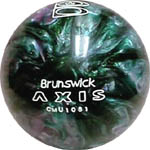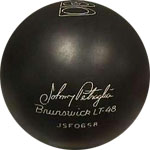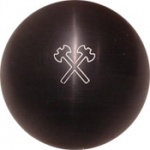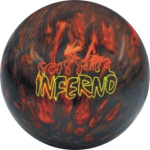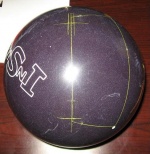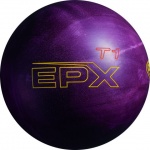Difference between revisions of "Coverstock"
Trackbowler (talk | contribs) |
m (→Definition) |
||
| (2 intermediate revisions by the same user not shown) | |||
| Line 1: | Line 1: | ||
==Definition== | ==Definition== | ||
| − | Coverstock is defined as the outer most portion of a | + | Coverstock is defined as the outer most portion of a bowling ball that makes contact with the lane. |
Coverstock material accounts for roughly 80% of the reaction seen on the bowling lane.<br /> | Coverstock material accounts for roughly 80% of the reaction seen on the bowling lane.<br /> | ||
Coverstocks are made out of 6 different types of material. | Coverstocks are made out of 6 different types of material. | ||
| Line 12: | Line 12: | ||
* Epoxy | * Epoxy | ||
| − | Each of these materials generate different amounts of friction on a bowling | + | Each of these materials generate different amounts of friction on a bowling lane, this causing different reactions. |
__TOC__ | __TOC__ | ||
| + | |||
==Plastic/Polyester== | ==Plastic/Polyester== | ||
[[Image:Axis.jpg|thumb|right|Example of a plastic coverstock ball.]] | [[Image:Axis.jpg|thumb|right|Example of a plastic coverstock ball.]] | ||
| Line 45: | Line 46: | ||
[[Image:insite1.jpg|thumb|right|150px|Example of a particle coverstock ball.]] | [[Image:insite1.jpg|thumb|right|150px|Example of a particle coverstock ball.]] | ||
Particle coverstocks are very similar in makeup to reactive resin bowling balls. What makes a particle coverstock different is the addition of microscopic pieces of material, reaching through oily conditioner to make contact with the lane surface. | Particle coverstocks are very similar in makeup to reactive resin bowling balls. What makes a particle coverstock different is the addition of microscopic pieces of material, reaching through oily conditioner to make contact with the lane surface. | ||
| − | For particle coverstocks to perform at their best they must have a certain amount of | + | For particle coverstocks to perform at their best they must have a certain amount of oil to work with. Otherwise particle coverstocks will create too much friction on the lane thus causing the ball to have less energy at the pins, potentially causing a roll characteristic known as rollout. The picture to the right shows microscopic particles reflecting the light from a camera flash.<br /><br /><br /><br /><br /><br /><br /> |
==Epoxy== | ==Epoxy== | ||
Latest revision as of 20:08, 4 February 2012
Definition
Coverstock is defined as the outer most portion of a bowling ball that makes contact with the lane.
Coverstock material accounts for roughly 80% of the reaction seen on the bowling lane.
Coverstocks are made out of 6 different types of material.
- Plastic/Polyester
- Rubber
- Urethane
- Reactive Resin
- Particle
- Epoxy
Each of these materials generate different amounts of friction on a bowling lane, this causing different reactions.
Contents
Plastic/Polyester
Polyester is the least aggressive coverstock available, thus reacting the least in the oily part of the lane and least on the dry portion of the lane. Plastic coverstock balls are usually reserved for situations where a bowler wants to go as straight as possible, such as spare shooting, or reserved for extremely dry lanes, where control and minimal reaction is a must.
Most plastic balls do not come with a core, as having the dynamics of a core inside can be costly to create and have a very marginal benefit on the lanes. Plastic balls with a core tend to cater to a very distinct reaction type.
Rubber
Rubber is an old coverstock material from before the 1980's when Urethane was first released.
Rubber offers slightly more reaction than plastic, and very similar to urethane. Drilling rubber balls can be an unpleasant and unhealthy experience. During the drilling process the rubber coverstock had the tendancy to heat up from friction due to the drill bit partially melting the softer rubber shell, emitting a profound odor most can identify with if they've drilled a rubber ball.
Urethane
Urethane began the original "power boom" most bowlers enjoy about the game now. Urethane has greater angle and ability to cover more boards than rubber or plastic coverstocks. The first urethane coverstock was created for the AMF Angle. The urethane covertock revolutionized the game, and provided the base material for reactive coverstocks that are very popular today.
Reactive
This category of coverstock is the most popular produced in the world of bowling in this era. Around 1990 manufacturers added reactive resin material to a urethane base to produce a ball that is more aggressive in reaction to friction at the end of a bowling lane. This violent reaction causes the ball to enter the pocket at a greater angle, thus having a greater carry percentage over rubber, plastic and urethane coverstocks. What causes the aggressive reaction of a reactive ball is the resin added to the urethane shell to create mircoscopic pores in the ball, which grab the lane, and make the surface of the ball feel tacky. Without question, reactive covertock bowling balls have assisted in the scoring boom within the sport of bowling since the early 1990's. Reactive coverstock can be created with a variety of surfaces and makeups.
Solid
A solid reactive ball has the tendancy to react the earliest out of the 3 categories of reactive coverstocks due to the greatest amount of microscopic reactive pores on the surface. Reactive solids come with all sorts of different finishes, including, polished, sanded, rubbing compound buffed.
Pearl
The difference between a solid reactive ball and a pearl reactive ball is the addition of mica to the coverstock chemical makeup. Mica's inclusion into the coverstock roughens out the microscopic pores to a certain degree, causing the reaction to the dry part of the bowling lane to be extended. Reactive pearl bowling balls are known for their ability to react very fast to friction. Mica flake also adds a little "sparkle" to the bowling ball's surface.
Hybrid
A hybrid reactive coverstock is a combination of solid reactive and pearl reactive coverstocks. Manufacturers recently have been creating these hybrid coverstock bowling balls to take advantage of the benefits of both pearl and solid coverstocks. Often these hybrid bowling balls offer the midlane reaction of a solid reactive and the backend reaction of a pearl reactive coverstock..
Particle
Particle coverstocks are very similar in makeup to reactive resin bowling balls. What makes a particle coverstock different is the addition of microscopic pieces of material, reaching through oily conditioner to make contact with the lane surface.
For particle coverstocks to perform at their best they must have a certain amount of oil to work with. Otherwise particle coverstocks will create too much friction on the lane thus causing the ball to have less energy at the pins, potentially causing a roll characteristic known as rollout. The picture to the right shows microscopic particles reflecting the light from a camera flash.
Epoxy
Epoxy is the newest bowling ball coverstock that offers increased traction throughout the lane from oil to dry. The first epoxy coverstock was created for the Columbia 300 EPX-T1. The EPX-T1 is known for its incredible overall hook, but has well documented issues with coverstock durability, thus affecting the staying power of this type of coverstock. It is apparent that coverstock durability needs to be improved for future releases of epoxy coverstock to be successful.
